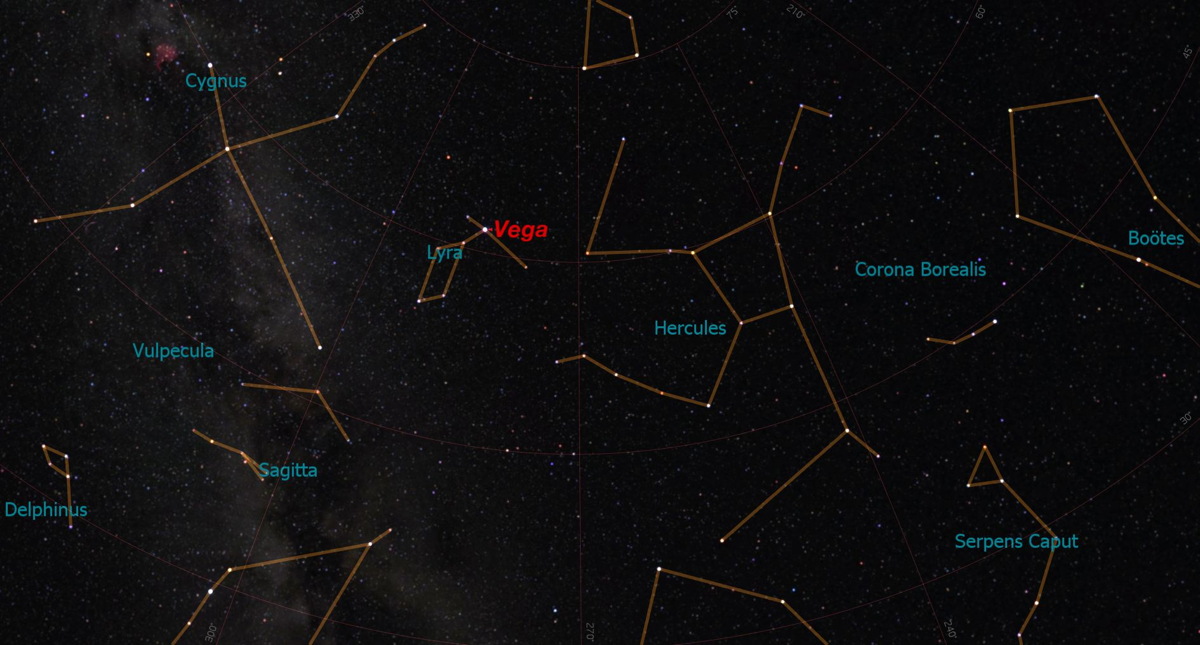Vega: The North Star of the Past and the Future
Vega is a bright star located just 25 light-years from Earth, visible in the summer sky of the Northern Hemisphere. The star is part of the constellation Lyra and, with the stars Deneb and Altair, forms an asterism known as the Summer Triangle.
The star is only about 450 million years old, which makes it a youngster compared to our own solar system (which is 4.6 billion years old). Studies of Vega help astronomers learn more about solar systems that are in the early stages of their formation.
Because the Earth's axis wobbles, our perception of north gradually shifts to different stars over a 26,000-year cycle. Vega was the North Star several thousand years ago, and it will regain that status in about 12,000 years.
Locating Vega
Vega is almost directly overhead at midnorthern latitudes on midsummer nights. Vega sinks below the horizon for only 7 hours a day and can be seen on any night of the year.
Farther south, Vega lies below the horizon for a longer period, but in Alaska, northern Canada and much of Europe, Vega never sets. The star's location is:
- Right ascension: 18h 36m 56.3s.
- Declination: 38 degrees 47 minutes 01 second.
Early observations
Because Vega's blue-white light is so bright — the star has an apparent magnitude of 0.03 — it features prominently in ancient cultures, ranging from the Chinese to the Polynesians to the Hindus. Vega's name comes from the Arabic word "waqi," which means "falling" or "swooping."
"This is a reference to the time when people regarded the constellation Lyra as a swooping vulture rather than a lyre," wrote Michael Anissimov on the website Wisegeek.
Breaking space news, the latest updates on rocket launches, skywatching events and more!
The name of Vega and those of other astronomical targets honor the traditional importance of astronomy in Islam, noted one researcher. Following the stars allowed believers to mark the times of prayer and festivals, as well as to find the holy city of Mecca.
"Thus, hundreds of stars and constellations have Arabic names, such as Altair, Deneb, Vega and Rigel," wrote Nidhal Guessoum, an astrophysicist at the American University of Sharjah in the United Arab Emirates, in a 2013 article published in the journal Nature.
In modern times, Vega was the first star to be photographed, other than the sun. Astronomers captured the image through the daguerreotype process at Harvard College Observatory, using a 15-inch (38 centimeters) refractor, on July 16-17, 1850.
The star was also chosen for the first spectrographic image, in 1872. amateur astronomer Henry Draper was the first to break down Vega's light to reveal the various elements that make up the star.
Vega in recent years
Vega rose to prominence in popular culture in the late 1990s after Carl Sagan's novel "Contact" (1985, Simon & Schuster) was adapted into a Hollywood movie. Starring Jodie Foster, the movie followed an astronomer working on the search for extraterrestrial intelligence (SETI) who discovers a signal appearing to emanate from Vega.
Telescopic observations in 2006 revealed that Vega is whipping around so quickly that its poles are several thousand degrees warmer than its equator. The star, which rotates every 12.5 hours, is at 90 percent of its critical rotation speed, or the velocity at which the object would tear itself apart.
In early 2013, astronomers announced that they had discovered an asteroid belt surrounding Vega, suggesting the possibility of planets within the rocks' midst. The layout (which resembled that found near the star Fomalhaut) suggests that there are two areas: an outer region with icy asteroids and a region closer to the star, where warmer space rocks reside.
Scientists are examining bright stars like Vega more closely using NASA's TESS (Transiting Exoplanet Survey Satellite) mission, which launched in 2018 to conduct an all-sky survey. While the primary mission of TESS is to search for exoplanets, the satellite will also search for signs of star variability. TESS's examination of Vega and similar stars will help scientists learn more about the early stages of star evolution.

Elizabeth Howell (she/her), Ph.D., was a staff writer in the spaceflight channel between 2022 and 2024 specializing in Canadian space news. She was contributing writer for Space.com for 10 years from 2012 to 2024. Elizabeth's reporting includes multiple exclusives with the White House, leading world coverage about a lost-and-found space tomato on the International Space Station, witnessing five human spaceflight launches on two continents, flying parabolic, working inside a spacesuit, and participating in a simulated Mars mission. Her latest book, "Why Am I Taller?" (ECW Press, 2022) is co-written with astronaut Dave Williams.

